Pattern Recognition #245 - To Infinity and Beyond!
Features Opinion Pattern Recognition
berryjon
30 June 2022
392 views
30 June 2022
392 views
Hello everyone! This is Pattern Recognition, TappedOut.Net's longest running article series as written by myself, berryjon. I am something of an Old Fogey who has been around the block quite a few times where Magic is concerned, as as such, I use this series to talk about the various aspects of this game, be it deck design, card construction, mechanics chat, in-universe characters and history. Or whatever happens to cross my mind this week. Please, feel free to dissent in the comments below the article, add suggestions or just plain correct me! I am a Smart Ass, so I can take it.
Today's line of discussion comes from chat on our Discord, which again, is something you should all join, and was in response to a question about priority and what happens when people don't stop doing what they are doing? Well, I slightly misread the nature of the question, and found a ruling that sorta addressed the initial question, but not quite.
But that lead to my article today, as my error becomes your entertainment!
Let's talk Infinite Combos.
Now, I've discussed the nature of one in the past, specifically The Great Machine, and how that worked, as well as its Kaladesh imitator. Well, today, I'm going to be talking about how these work in the general, what they are, what they are not, and when something only pretends to be a full infinite combo.
So let's start by actually setting down what an Infinite Combo is. Because I'm pretty sure that most of you think you know what an Infinite Combo is, but are actually wrong and are thinking about one of the other things we'll be talking about today, namely Arbitrarily Large Combos.
A TRUE Infinite Combo is an interaction between two or more cards that once begun, cannot be stopped without outside interference. It is a self-sustaining interaction of triggers and abilities that require only the initial input and run until the game is won or ends in a draw.
Time for an example.
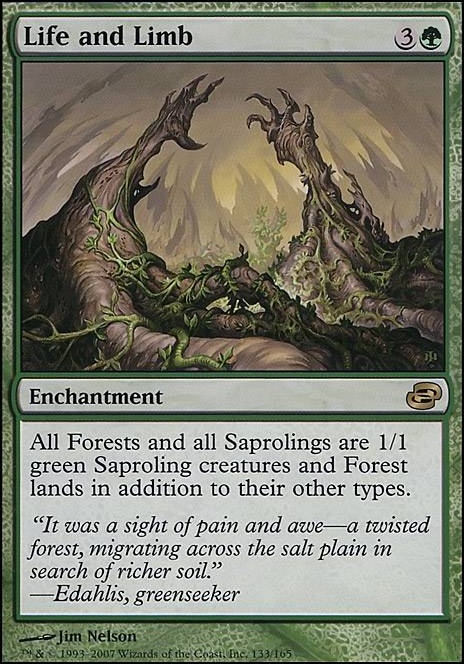
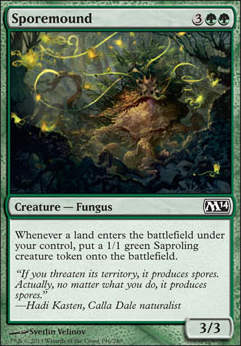
Life and Limb is an Infinite Combo with Sporemound.
Allow me to explain. Sporemound creates a 1/1 Saproling token whenever a land enters the battlefield. This is a simple effect, and I've put it into my Thelon of Havenwood deck, (because Slimefoot, the Stowaway is easy mode), so there is nothing odd there. It's free creatures! How could you say "NO!" to that?
Well, Life and Limb is another card that turns all your Forest cards into 1/1 Saprolings and all your Saprolings into Forests. Given that I talked about ManLands last week, you should see how this could be useful. And it is!
So here's the problem. If you have both of them in play, and you play a Forest, what happens?
Well, what happens is that Sporemound looks at the Forest that entered the battlefield, and says "Oh, hey! That's a Forest that entered the battlefield! I'm going to make a Saproling now" and does so.
Life and Limb sees that Saproling and says "That's cool! You know it's also a Forest, right?"
So Sporemound replies: "Why so it is! Thank you for reminding me!"
Life and Limb: "No problem, glad to help."
Sporemound: "Oh, hey! That's a Forest that entered the battlefield! I'm going to make a Saproling now."
Life and Limb: "That's cool! You know it's also a Forest, right?"
Sporemound: "Why so it is! Thank you for reminding me!"
Life and Limb: "No problem, glad to help."
Sporemound: "Oh, hey! That's a Forest that entered the battlefield! I'm going to make a Saproling now."
Life and Limb: "That's cool! You know it's also a Forest, right?"
Sporemound: "Why so it is! Thank you for reminding me!"
Life and Limb: "No problem, glad to help."
... AND SO ON.
This is a true Infinite Combo. Once the pieces are in place, and activated, there is no way to stop the interaction, and no viable out for it. This invokes Rule 104.4B, which states:
104.4b: If a game that’s not using the limited range of influence option (including a two-player game) somehow enters a “loop” of mandatory actions, repeating a sequence of events with no way to stop, the game is a draw. Loops that contain an optional action don’t result in a draw.
And in there is the important part to take away from a real Infinite Combo, there is no MAY. You MUST perform the actions. And perform them until the combo is stopped by an outside action. Because the game stops until these resolve, but they can't as they keep going in a loop, the game has to end. In a Draw, because technically no one wins and no one loses.
You are, of course, subject to the rules of the location you are playing in, allowed to express your displeasure with the person who just did that in a reasonable and polite manner.
No, what people think, when they think of an Infinite Combo, is the slightly more wordy and less fun to say, Arbitrarily Large Combo.
An ALC goes through all the motions of an Infinite Combo, and can often use the same cards in the process. The difference, however, lay in the reading of 104.4b. That vital inclusion of a may. You May perform an action, and as said action that perpetuates the combo is not required, it can be shorted at any time simply by declaring that it stops.
An example again;
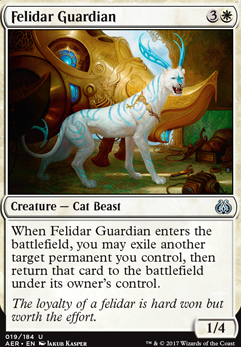
 Saheeli Rai in play, and you play Felidar Guardian. The Guardian can 'flicker' any permanent you control (even lands!) in order to reset them. What happens is that the Guardian flickers Rai, resetting her loyalty to 3. From there, she uses her -2 ability on the Guardian, creating a token copy of the Guardian. This Guardian, having entered the battlefield, then flickers Rai again, resetting her loyalty, and allowing her to repeat her previous action to make a new copy of the Guardian, and so on and so forth until you have an ... Arbitrarily Large Number of Cats that you swing for the win with.
Saheeli Rai in play, and you play Felidar Guardian. The Guardian can 'flicker' any permanent you control (even lands!) in order to reset them. What happens is that the Guardian flickers Rai, resetting her loyalty to 3. From there, she uses her -2 ability on the Guardian, creating a token copy of the Guardian. This Guardian, having entered the battlefield, then flickers Rai again, resetting her loyalty, and allowing her to repeat her previous action to make a new copy of the Guardian, and so on and so forth until you have an ... Arbitrarily Large Number of Cats that you swing for the win with.
The nature of ALC's as infinite combos hinges on that single word, MAY, and because of that, usage of the combo creates an effectively unlimited result, but by the rules, has to be capped at some point. Usually, that point is when the amount of whatever resource your are generating is sufficiently large that you can do what you want, and the only question is how you close out the game.
I highly recommend watching this Extra Turns game of Commander to see an ALC in action, as well as how it was resolved.
Now, ALC's have been around for the entirely of the game, and so a little bit of history trivia for you. Wizards tried to, or rather, raised as the possibility of a new rule, where any ALC or IC would be hard-capped at 100 iterations. It it attempted to happen a 101st time, even if that instance was not concurrent, then the action would fail. It never really got out of the 'this is an idea, let's try it out!' phase for a variety of reasons, and as such, it's just a bit of trivia, and nothing to write home about.
In addition, the commentary on the Discord (why haven't you joined yet?) is that players never have an ALC of Mana. Their Mana Pool is "Yes." As in, the answer to the question of if they can pay for the effect in mana is always "Yes."
Now, stepping even further away from an Infinite Combo, we have situations where you have what would normally be an ALC, or even a full on Infinite Combo, but there is some externally limiting factor to it. That there is some resource in the game that will eventually run out and stop the combo when it runs out of metaphorical gas.
Typically, that resource is either someone's life total - I didn't say it had to be a resource you control - or the size of a deck, or even how many creatures you have on the battlefield. These sorts of non-infinite combos have all the hallmarks of them, or of an ALC though, it's just that the end result approaches zero for something, rather than having an unbounded upper limit.
(Note to self - see if this post system can handle Wolfram Alpha math formulas at some point)
Take this combo for instance, a pretty well known classic in mono-:
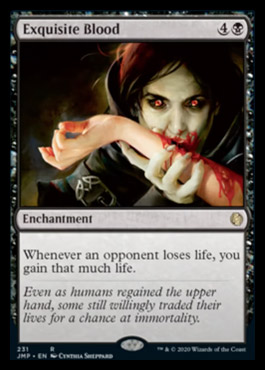
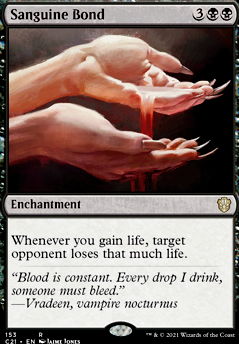
Here, we have a very simple interaction. You gain life from any source, and Sanguine Bond triggers, causing an opponent to lose that much life as well. However, Exquisite Blood sees the loss of life, and triggers off of that, to give you the same amount of life. This triggers the Bond to cause more life loss, which triggers Blood and so on and so forth.
This is the exact same mechanics that are invoked in a proper infinite Combo, but what makes this different is that there is a limited resource in play - namely the sum life total of your opponents. That there is a point in the Combo where a player can be said to have won or lost is what makes this different.
Just don't try to do this when your opponent has a Platinum Angel out, as then you get that lovely Draw state.
But an Infinite or ALC can become this sort of Combo when there are additional cards added, creating more triggers that move the game state from an endless loop to having an out that taps into a limited resource. Take, for example, Purphoros, God of the Forge. This card deals 2 damage to each opponent whenever a creature enters the battlefield under your control. And recall that the very first infinite combo I talked about was one that produced infinite creatures.
Because of this, if Purphorous is on your board when you go off with infinite Forest Saprolings, the Infinite Combo stops being Infinite and becomes mathematically bounded by the life totals of your opponents. This stops that infinite combo from becoming truly infinite in the first place.
This sort of limitation is where most players want their Combos to go. They want to be able to fire it off without needing to worry too much about accidentally forcing a Draw, and rather go into a position where they win as a side effect or even the goal of the Combo.
And so, there you have it. Infinite Combos. What they are. What they are not. How they work, and don't work, and what happens when they get out of control. I hope this was informative for all of you, and that you have a better understanding of how most EDH games close out.
Join me next week, when I talk about something else. What? I have a couple ideas, so we'll see what comes up with the long weekend.
Until then please consider donating to my Pattern Recognition Patreon. Yeah, I have a job, but more income is always better. I still have plans to do a audio Pattern Recognition at some point, or perhaps a Twitch stream. And you can bribe your way to the front of the line to have your questions, comments and observations answered!
Gidgetimer says... #2
The trend of people rebelling against the term "infinite combo" as it is commonly used confuses me. For as long as I have played magic (going on 10 years now) "infinite combo" has been used to describe an interaction that can be repeated ad infinitum. Common usage thus dictates that all three interactions described are infinite combos.
Root beer isn't beer, white chocolate isn't chocolate, and infinite combos are not necessarily true infinites.
Delphen7 says... #1
All the articles are neat, but this one especially so.
It might be worth noting that there is one infinite 'combo' with only a single source; a copy of Garruk Relentless Flip with less than 3 counters.
July 2, 2022 5 p.m.